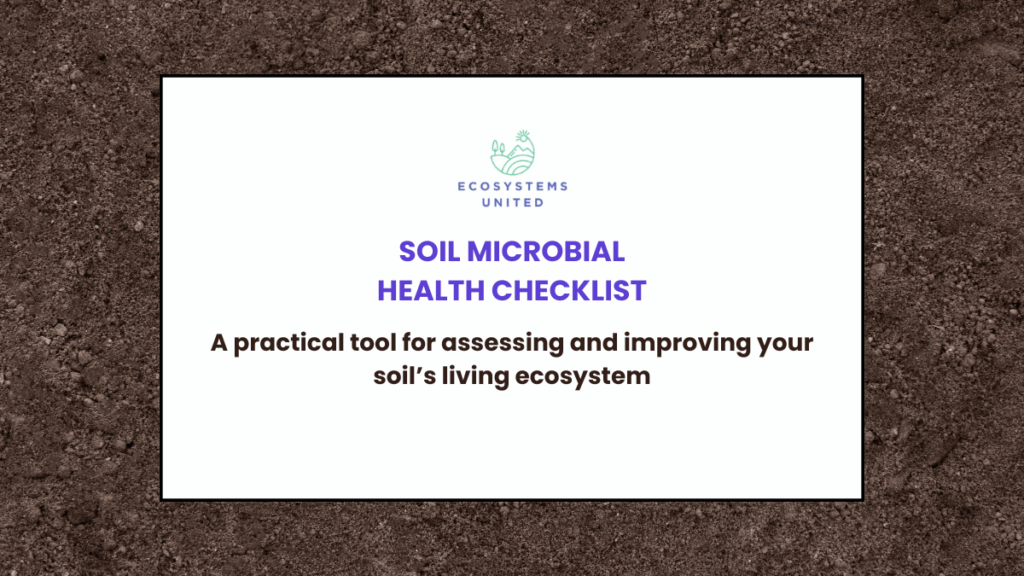a soil microbial health checklist to track soil health

Your soil isn’t just dirt. It’s a bustling metropolis of microscopic life that directly impacts your bottom line. Billions of bacteria, fungi, and other microorganisms work 24/7 to cycle nutrients, retain water, suppress disease, and build the structure that supports healthy crops. Our Soil Microbial Health Checklist helps you assess whether this underground ecosystem is thriving or falling behind.
But how can you tell if your soil biology is working for you?
The soil microbial health revolution
Farmers across the country are discovering that soil microbial health is the key to profitable, resilient agriculture. Many are cutting input costs, improving drought tolerance, and stabilizing yields by focusing on biology. Yet until now, assessing soil life required expensive lab tests or advanced expertise.
That’s why we created the Soil Microbial Health Checklist. It’s a field-ready tool that helps you evaluate and improve soil biology using simple, visual methods.
Why this soil microbial health checklist
Unlike generic soil health assessments, our checklist focuses specifically on the biological activity that drives soil function. It’s designed around three core principles:
Observable Science: Every indicator in the checklist is based on visual cues and simple tests you can perform with basic farm tools. No lab equipment required.
Actionable Results: Rather than just telling you what’s wrong, the checklist provides specific practices based on your unique situation to improve your soil’s microbial community.
Progress Tracking: Built-in monitoring tools help you document improvements over time so that you can see the return on your soil health investments.
Inside the 3-part sil microbial health checklist
Part 1: Self-Assessment
Evaluate your current management practices across five key areas that directly impact soil microbial health:
- Soil Disturbance: How your tillage practices affect fungal networks
- Soil Coverage: Whether you’re feeding soil biology year-round
- Plant Diversity: How crop rotations support microbial diversity
- Inputs & Amendments: Whether your fertilizer approach builds or depletes soil life
- Pest Management: How chemical interventions impact beneficial microorganisms
Part 2: Microbial Health Indicators
Learn to read the signs of a healthy soil ecosystem through:
- Visual Indicators: From the earthy smell of actinomycetes to the white threads of mycorrhizal fungi
- Functional Tests: Simple field tests, like the “cotton fabric test,” that reveal microbial activity levels
- Soil Structure Assessment: How to evaluate aggregation and water infiltration as indicators of biological health
Part 3: Improvement Plan
Transform your assessment results into concrete action steps:
- Priority Setting: Identify the three most impactful changes for your operation
- Practice Recommendations: Specific techniques for boosting microbial health
- Progress Tracking: Annual monitoring system to document improvements
Want more helpful tools and templates for on-farm sustainability and success?
Real results from real farms
Farms using microbial-focused soil management are seeing measurable benefits:
- Input Cost Reduction: 30-50% decreases in fertilizer needs as soil biology improves nutrient cycling
- Water Efficiency: Better soil structure and organic matter leading to 20-40% improved water retention
- Yield Stability: Reduced crop loss during weather extremes due to enhanced soil resilience
- Premium Markets: Access to regenerative and organic certification programs
The economics of soil biology
Investing in soil microbial health isn’t just good for the environment; it’s good for your farm’s profitability. Operations that build soil biology typically see a return on investment within 3-5 years through reduced input costs and improved productivity. The checklist helps you track these economic benefits alongside the biological improvements.
Get started with your soil health journey
Whether you’re managing 50 acres or 5,000 or just starting to think about soil health or already implementing regenerative practices, this checklist meets you where you are. It’s designed to work for:
- Row crop operations transitioning to reduced tillage and cover crops.
- Vegetable growers building soil biology for pest and disease suppression.
- Livestock operations integrating grazing management with soil health.
- Specialty crop producers reducing inputs while maintaining quality.
The best time to assess your soil’s microbial health was yesterday. The second-best time is today.
Download Your Free Checklist
Ready to unlock your soil’s hidden potential? Download the Soil Microbial Health Checklist and take the first step toward building a more profitable, resilient farming operation.
Your soil ecosystem is waiting. The question is: Are you ready to start listening?
Want to dive deeper into soil health strategies? Explore our comprehensive guides on regenerative agriculture practices and join thousands of farmers building healthier soils and stronger bottom lines.





